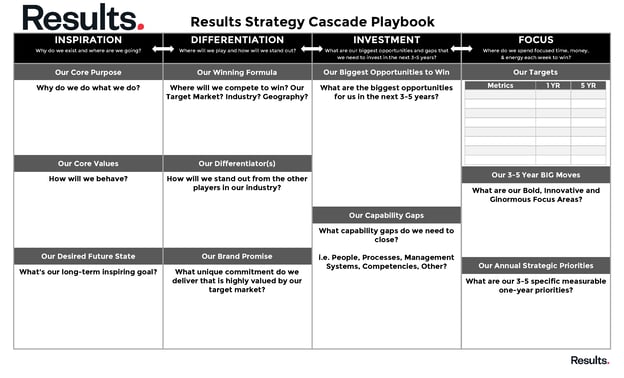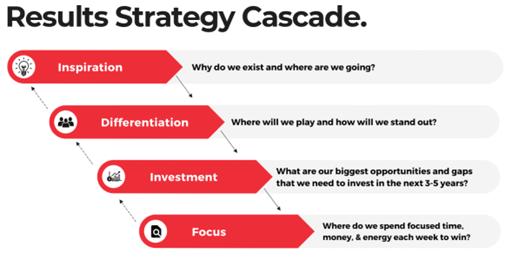Results has been helping companies craft their business strategies for nearly two decades. In that time, we have used many different models, frameworks and thought starters to help leadership teams decide how to compete and what to focus on.
One of our core values is Simplicity is Genius. Our clients rely on us to cut through the deluge of information, research and best-practices and provide the simplest approaches and tools.
With that in mind, we developed the Results Strategy Cascade. This tool ensures alignment between intentions and actions. It helps leaders operationalize their vision so that it has meaning in day-to-day projects, priorities, and actions, and defines how the organization will win. There is always an abundance of opportunities; the essence of strategy is focusing on what to say “no” to.
We intentionally invoke the word ‘cascade’ thanks to the influence of Roger Martin who appeared as our guest on Unleashed in 2022. The most important part of a decision cascade is that all the decisions must align with and support one another. It also implies that issues or roadblocks that may arise further down the cascade may force a rethink of the higher order decisions. Thus strategy development is iterative and may move up and down the ladder of choices.
What’s the Inspiration?
Inspiration answers the question, “why does our company exist?” It’s been called the core purpose, the why, or the wicked problem that the organization is trying to solve. It can sometimes border on unattainable, impossible, or irrational, and becomes an overriding true north star for all other decisions in the cascade.
Disney’s core purpose is “to make people happy.” Notice it has nothing to do with theme parks, and the company has found a multitude of ways to execute on this purpose.
Core values are also part of inspiration if they reflect the standards of behaviour we expect and espouse. Most companies have core values these days, but many don’t live them. Too often they are just words on a plaque or website and have not been integrated into the culture. The best companies operationalize and live their core values every day. They are talked about, recognized, and integrated into key processes like recruiting, performance management and decision making.
A final element of Inspiration is defining the end point or the desired future state. Jim Collins refers to this as the Big Hairy Audacious Goal (BHAG), an objective that can be measured and helps everyone see progress towards that goal. Having “a computer on every desk and in every home,” was Microsoft’s BHAG in its infancy. This can be supplemented with other details of, “what it will look like when we get there?” often called the painted picture.
How Do We Differentiate?
The next decision in the cascade is how your brand will stand out. Research has shown that brands with clear differentiation are the most powerful and successful over time. Those that are the same as their competitors degrade to commodity status, and providers have no competitive advantage other than lowest price.
“Strategy is about setting yourself apart from the competition. It’s not a matter of being better at what you do – it’s a matter of being different at what you do.” Michael Porter
Trying to be all things to all people is a losing approach. Your firm must decide where to lead; one or two characteristics that become the focus of your competitiveness.
Many well-known brands have clear leadership in just one characteristic of differentiation:
- Costco – price leadership
- Southwest Airlines – on-time leadership
- Volvo – safety leadership
- Apple – design innovation leadership
- Amazon – convenience leadership
These brands stand out leading with a single benefit. They need to be at least threshold in other benefits (e.g., Volvo must still have vehicles with reasonable fuel efficiency, price, and post-purchase support) but they focus and promote leadership with a single buyer benefit.
Another approach to differentiation is to specialize, and therefore establish a stronger expertise and affiliation with a particular market segment. Every buyer wants to buy from a brand that services people just like them. Driving through my neighborhood recently I noticed a sign for a real estate agent that specializes in the area I live. That is noticeable and if I was looking for real estate services, I would consider reaching out to her.
Specialization can occur across innumerable definitions – geography, age, stage of life, gender, household income, hobbies and even psychographic or behavioural categories like extroverts, intuitive thinkers, learning tendencies, and others.
Where Do We Invest?
Companies make a multitude of investments every day. Many of these are common and shared across players in all industries – raw materials, employees, equipment, physical space, professional services, etc. Answering the “Where Do We Invest?” question is not about these investments. These are so-called “table stakes.”

Rather, “Where Do We Invest” is about the strategic investments that need to be made to maintain or acquire a winning position aligned to the previous decisions made in this cascade.
For example, if a company wants to differentiate in customer service, then extraordinary investment in customer service recruiting, training, and tracking systems will be required. If a company’s inspiration is to improve the lives of employees throughout western Canada, then investment is needed in branches or distribution partnerships throughout that entire region.
Strategic investment decisions are informed by either gaps or a current position that can too easily be replicated by competitors. Quiznos had a short-lived advantage when they baked their own bread on site, but as soon as Subway replicated that the advantage disappeared.
Well known tools like SWOT Analysis (Strengths, Weaknesses, Opportunities and Threats) or Porter’s Five Forces can help pinpoint where these investments need to be made.
The decisions made in this area are three-to-five-year investment categories, and will commonly be things like geographic expansion, product development, technology innovation or strategic partnerships that will take longer time periods to come to fruition.
Investing isn’t just about money. It’s about any scarce resource. Strategic investments include all inputs including key people’s time, energy, and focus. This phase is as much about saying YES to some things as it is saying NO to others.
What’s the Annual Focus?
Annualized thinking has long been a corporate norm. Budgets, fiscal year ends, annual reporting, vacation day allocations and various other systems tend to follow nature’s one-year cycle. Therefore, as we increase the specificity of strategic decisions in this cascade, using a one-year timeframe makes sense.
The Annual Focus defines what strategic projects are going to be undertaken in the next twelve months. Strategic projects (Annual Priorities) should link to previous decisions in this cascade and be specific in terms of the deadline and clear measures of success. We call these committed outcomes, and there should be no ambiguity at year end whether the priority was completed successfully or not.
Annual strategic projects should be well outside normal operations. We call them B.I.G. Moves – projects that are Bold, Innovative and Ginormous. This implies that they are far reaching in terms of scope, investment, and focus.
Not all B.I.G. Moves will be doable in twelve months. Entering a new geographic region (e.g., new country) or building a new facility could take years. In these cases, the B.I.G. Move should be defined in a way that specifies the objective outcomes that will be completed by year end.
Further, not all change or improvement projects need to be defined as B.I.G. Moves. Innovation and learning should be taking place in all areas and levels if the organization has a culture of innovation.
Alignment
Decision cascades are about consistency and alignment. By aligning inspiration, differentiation, investments and focus, your company can ensure every team and individual is pulling in the same direction.
To that end every employee should see and understand the strategic cascade. Engaged employees want to know that they are working side-by-side with others who have the same goals and objectives. Effective organizations have the right people working on the right work at the right time with no duplication or overlap.
This is the path to better results.
Unleashing the Potential of Your Organization
Below is a downloadable template for you to create your own strategy cascade playbook:


If you’d like to learn more about how to build your own strategy cascade, or other ways you can take the simpler path to creating a great business, connect with us or consider attending one of our upcoming leadership events.




